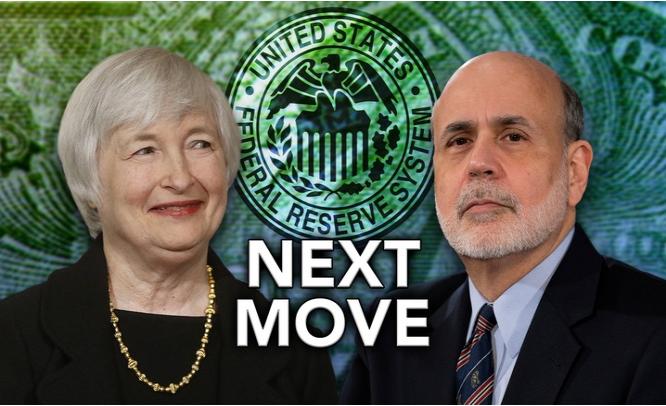As was widely anticipated, the US Fed continued with its “tapering” plan to cut asset purchases by another $10 billion a month while leaving interest rates unchanged, Team IFM reports
Washington, January 31: As was widely anticipated across all markets, the US Federal Reserve Bank announced on Wednesday that it will reduce its asset purchase by $10 billion a month to bring it down to $65 billion a month from the current rate of $75 billion a month on the back of improved economic activity and labour market conditions. At the same time it announced that it will maintain its short-term interest rates (federal funds rate) of 0 to 0.25 percent as long as the unemployment rate remains above 6.5 percent
At the end of its two-day meeting on January 28-29, the FOMC voted unanimously to continue with its policy of a “measured reduction in the pace of its asset purchases ” that was started in December, 2013, as yet another step in its planned “tapering” of the Quantitative Easing stimulus programme launched to shore up the US economy following the Global Financial Crisis (GFC) in 2008.
Indicating its plans going forward, a statement from the FOMC, which Fed chief Ben Bernanke chaired for the last time, said “if incoming information broadly supports the Committee’s expectation of ongoing improvement in labor market conditions and inflation moving back toward its longer-run objective, the Committee will likely reduce the pace of asset purchases in further measured steps at future meetings.”
The statement however said that such paring of asset purchase was not on a “pre-set course” but “will remain contingent on the Committee’s outlook for the labour market and inflation as well as its assessment of the likely efficacy and costs of such purchases.”
Later during a press conference, when asked whether the Fed’s current policy will carry on under the incumbent chief Janet Yellen, who will take over from the end of January, Bernanke said “Yes, it will. I have always consulted closely with Janet, even well before she was named by the President, and I consulted closely with her on these decisions as well. And she fully supports what we did today.”
Wednesday’s policy move followed a December 18 decision to whittle down monthly asset purchase by $10 billion a month to $75 billion a month from $85 billion a month. Bernanke indicated that the “general range” of subsequent reductions would be $10 billion a month. he also emphasised that such reductions would be data-dependant and that the Fed would stop reduction in purchases “if the economy disappoints” while the pace of purchase could pick up “if the economy is stronger”.
Bernanke, who had earlier said the reduction process would be over by the middle of next year, however evaded citing any specific timeframe on Wednesday. Reiterating that the pace would be data-dependant, he said in answer to a
question that “If we’re making progress in terms of inflation and continued job gains—and I imagine we’ll continue to do, probably at each meeting, a measured reduction—that would take us to late in the year, certainly not by the middle of the year. If the economy slows for some reason or we are disappointed in the outcomes, we could skip a meeting or two. On the other side, if things really pick up, then of course we could go a bit faster, but my expectation is for similar moderate steps going forward throughout most of 2014.”
The outgoing chairman said while he believed inflation could go back to 2 per cent, there was always the possibility it could be higher depending on “special factors” such as healthcare costs and some other things that have been unusually low and might be reversed. “It’s not easy to – inflation cannot be picked up and moved where you want it,” he said. “It takes – it requires –obviously, some luck and some good policy.”
Markets Down:
Though the Fed Reserve policy announcement was expected, markets from Wall Street through Ankara to Tokyo tumbled, prompting Japan’s Economy Minister Akira Amari to say problems stemmed from “the US’s exit strategy”.
Japan, the worst regional performer this year, took the biggest hit, with the Nikkei 225 falling 3.3 per cent. “[Stock markets] are widely affected by problems surrounding the US’s exit strategy from quantitative easing,” Amari said.
“But the US is confident that the US economy is in a good enough condition to go ahead with the reduction of QE. So the market should take a more dispassionate view.”
Other Asian markets too fared no better, with the Hang Seng index of Hong Kong falling 1.6 per cent and the Shanghai Composite contracting 0.4 per cent despite the festive atmosphere on the eve of the Chinese New Year.
The US market, which had opened on a festive note Wednesday morning, sagged at day’s close wiping off the day’s gains. The Dow closed up a muted 28 points or 0.2 per cent after notching a high of 64 points in intra-day trading. Standard & Poor’s 500 fell one per cent.
Capturing the mood, the Chicago Board Options Exchange Market Volatility Index or the Vix index – a measurement of market volatility – shot 10 per cent.
The recent volatility in emerging markets was not mentioned in the statement that followed Wednesday’s meeting of the FOMC, and analysts say this was expected as the decision-making panel couldn’t afford to appear weak.
“The Fed would lose a lot of credibility if they blink over emerging markets. They have to act cool and collected by sticking to their plan of focusing on the US economy,” said Peter Boockvar, chief market analyst at the Lindsey Group.


